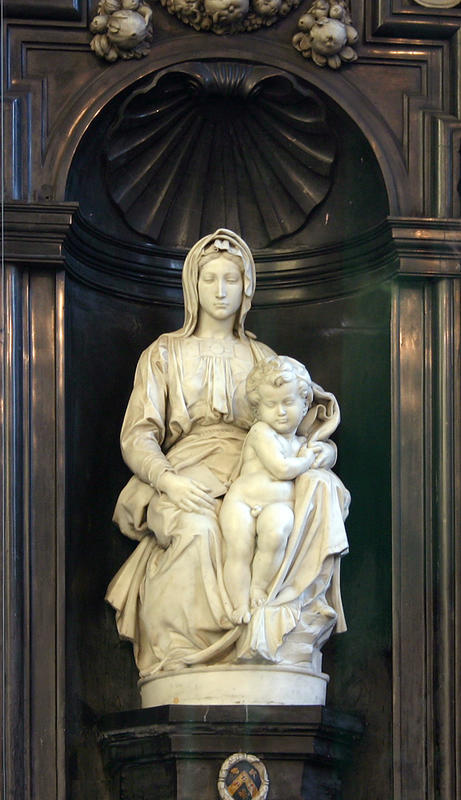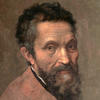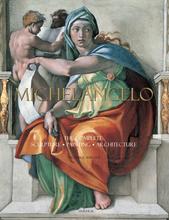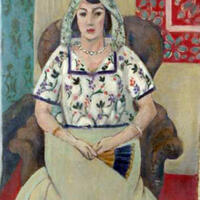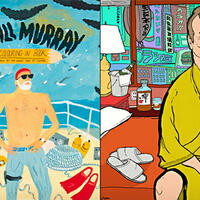More about Madonna of Bruges
- All
- Info
- Shop

Sr. Contributor
People can't get enough of Michelangelo's Madonna of Bruges, even though its depiction of the sweet baby Jesus has Benjamin Button syndrome.
The dour look of the just smaller than life-size Virgin and Child show that each knows what will happen when Mel Gibson casts Jesus in "The Passion." But it's a little difficult to see that look, since spectators can't view it from closer than 15 feet away. Not to mention the surrounding bullet-proof glass, installed after the Pieta at the Vatican was attacked in the 1970s by an Italian geologist who thought he was Jesus Christ. This is why we can't have nice things.
This was the only work by Michelangelo to leave Italy in his lifetime. A Flemish merchant purchased it while on a business trip to Florence. His idea was to use the Madonna as a deal-closer in securing a chapel for the burial of his family and friends. Which must have solicited many awkward thank yous when he finally revealed the surprise present he brought back from Italy. The ruse worked, but the donation was on condition that no one see the statue without the family's permission. So, to their ancestors, #sorrynotsorry.
Michelangelo didn't want anyone looking at the statue either, because it would probably piss off the Pope to know that the Madonna was heading out of the country. Pope Julius supposedly commissioned the work for an altar in Rome. Our morbid Flemish merchant, however, offered a better price and Michelangelo accepted. It's just business, bro. Mike got his way, as Vasari (huge Michelangelo fan) knew so little about the Madonna that he called it cast in bronze in his book "Lives of the Artists."
In addition to the Pope, this Madonna has been coveted by the biggest subsequent leaders/tyrants in European history. After Napoleon conquered Belgium, he requested that the Madonna be shipped to Paris in addition to all their paintings by Jan van Eyk and Hans Memling. The Madonna and most of the other pilfered artworks were returned to Bruges and the rest of Belgium after Napoleon's eventual defeat and exile.
At the height of Hitler's art nicking bonanza, AKA World War II, the Monuments Men fell upon Bruges specifically to rescue this piece. Arriving just days after it was stolen by Nazis. Oops. The Third Reich carted it off on mattresses in the back of a Red Cross truck like the Beverly Hillbillies. The Monuments Men eventually recovered the Madonna and countless other masterpieces from the Steinberg salt mine in Altaussee, an expansive storage unit with the art Hitler would have used to fill his planned Fuhrer Museum in Austria. The Madonna was returned to Bruges, where it patiently waits to be stolen by Europe's next megalomaniac warlord.
Featured Content
Here is what Wikipedia says about Madonna of Bruges
The Madonna of Bruges is a marble sculpture by Michelangelo of the Virgin and Child.
Michelangelo's depiction of the Madonna and Child differs significantly from earlier representations of the same subject, which tended to feature a pious Virgin smiling down on an infant held in her arms. Instead, Jesus stands upright, almost unsupported, only loosely restrained by Mary's left hand, and appears to be about to step away from his mother. Meanwhile, Mary does not cling to her son or even look at him, but gazes down and away. It is believed the work was originally intended for an altar piece. If this is so, then it would have been displayed facing slightly to the right and looking down. The early 16th-century sculpture also displays the High Renaissance Pyramid style frequently seen in the works of Leonardo da Vinci during the late 1400s.
Madonna and Child shares certain similarities with Michelangelo's Pietà, which was completed shortly before – mainly, Mary's flowing robe, and the movement of the drapery. The long, oval face of Mary is also reminiscent of the Pietà.
The work is also notable in that it was the first sculpture by Michelangelo to leave Italy during his lifetime. In 1504, it was bought by Giovanni and Alessandro Moscheroni (Mouscron) for 100 ducats. The Mouscron brothers were wealthy cloth merchants in Bruges, then one of the leading commercial cities in Europe.
The sculpture was removed twice from Belgium after its initial arrival. The first was in 1794 after French Revolutionaries had conquered the Austrian Netherlands during the French Revolutionary Wars; the citizens of Bruges were ordered to ship it and several other valuable works of art to Paris. It was returned after Napoleon's final defeat at Waterloo in 1815.
The second removal was in 1944, during World War II, with the retreat of German soldiers, who smuggled the sculpture to Germany enveloped in mattresses in a Red Cross truck. It was discovered a year later in Altaussee, Austria within a salt mine and again returned. It now sits in the Church of Our Lady in Bruges, Belgium. This is represented in the 2014 film The Monuments Men.
-
The statue being recovered from the Altaussee salt mine
Check out the full Wikipedia article about Madonna of Bruges

